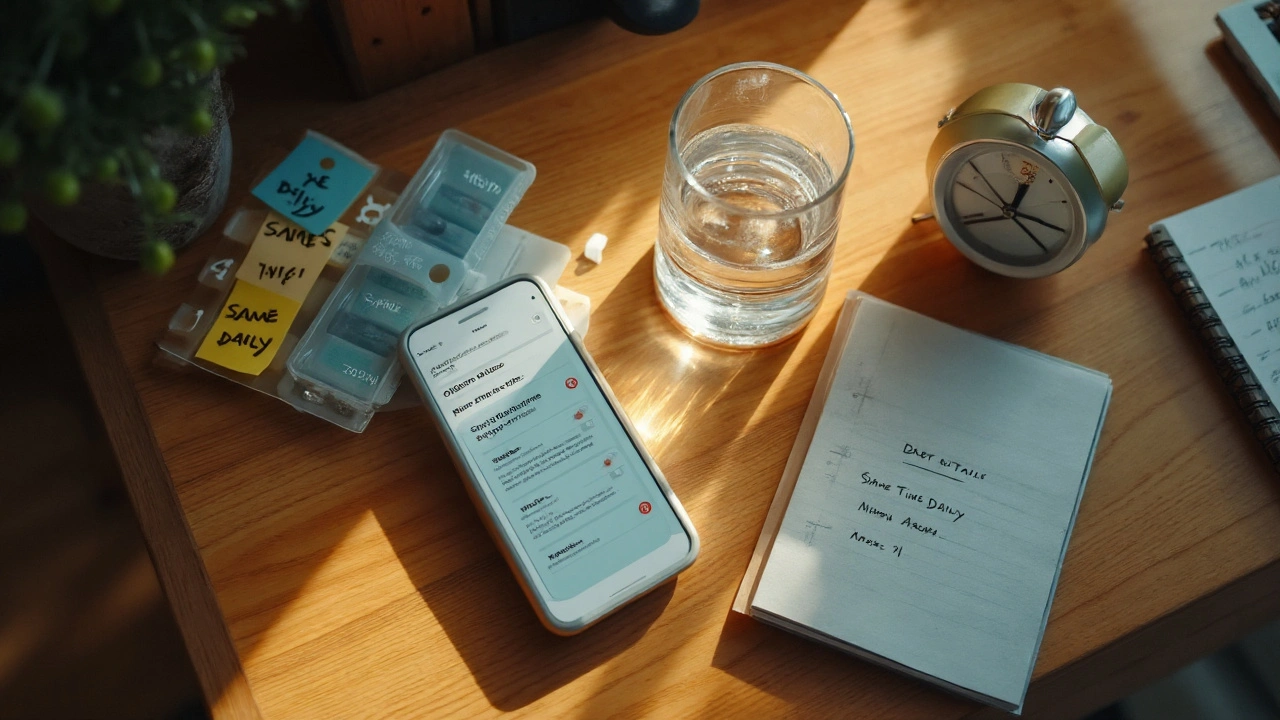You searched “Biktarvy” because you want the right page fast-usually the official label, reliable dosing details, side effects, and how to get it covered. This guide gets you there in a few steps, then gives you the practical stuff people actually use day to day: what to click, what to print, how to handle antacids, missed doses, insurance forms, and what to ask your clinician. No fluff. I’m Andy in Portland, and I’ve helped more than a few friends navigate HIV meds, Oregon insurance, and ADAP paperwork. Consider this your shortcut.
Get to the official Biktarvy info fast
Goal: reach the latest U.S. Prescribing Information, the Medication Guide, and the savings/patient assistance pages in the least number of clicks. Here’s the cleanest path without guesswork.
- Search exactly: “Biktarvy Prescribing Information PDF”. In results, look for the FDA label (site ending in fda.gov) or the manufacturer’s PI PDF (site ending in gilead.com). Open the most recent revision date (check the footer of the PDF; it should show a 2024 or 2025 update).
- Grab the Medication Guide (plain-English handout) the same way: search “Biktarvy Medication Guide PDF”. This is the version doctors hand out-useful for side effects, missed doses, and interactions you can read quickly.
- For cost help, search: “Biktarvy Advancing Access”. You want the manufacturer’s patient support program. From there you can find: copay coupon (for commercial insurance), patient assistance (for people without coverage), and benefits verification (to see what your plan covers).
- If you’re in Oregon and on OHP (Medicaid) or need ADAP, search: “Oregon CAREAssist ADAP”. That program can cover premiums and meds for eligible people with HIV. Expect to provide proof of income, Oregon residency, and HIV status from your clinician.
- If a clinician asked you to check drug interactions, search: “Biktarvy interactions FDA label” and jump to the “Drug Interactions” section of the prescribing info. Cross-check anything with antacids, rifamycins, anticonvulsants, and herbal products.
What to download or screenshot right now:
- The full Prescribing Information (PI) PDF-keep it on your phone.
- The Medication Guide-this is your plain-language backup.
- Savings program details-screenshot the eligibility page to share with a pharmacist or case manager.
Sanity check you’re on the correct site/pages:
- Prescribing Info shows the exact tablet strengths: bictegravir 50 mg / emtricitabine 200 mg / tenofovir alafenamide 25 mg (adult/adolescent) and the pediatric strength for smaller kids.
- The revision date on the PI is recent (not years old).
- Savings pages clearly state “no-cost medicine” or “copay support” and ask for standard items like insurance info, income, and prescriber details. If it asks for weird fees, you’re not on an official page.

What you’ll find there and how to use it
Here’s how clinicians and savvy patients read the label-and how you can make it actionable.
What is Biktarvy? It’s a complete, once-daily HIV-1 treatment in one pill: bictegravir (an INSTI), emtricitabine (FTC), and tenofovir alafenamide (TAF). No booster needed. It’s indicated for adults and for children who meet weight criteria (check the PI for current pediatric thresholds; as of 2025 it includes patients ≥14 kg, with specific lower-strength tablets for smaller kids).
Standard dosing: one tablet by mouth once daily, with or without food. Swallow whole. If swallowing is an issue, ask your pharmacist before crushing-changing the tablet can affect how the medicine works.
Missed dose rule of thumb: take it as soon as you remember. If it’s almost time for the next dose, skip the missed one-don’t double up. If you vomit within about one hour of taking it, consider that dose missed and take another. If it’s been longer, you’re likely fine and just take the next dose as scheduled.
Interactions you actually see in real life:
- Antacids and minerals: Aluminum/Magnesium antacids and supplements with iron or calcium can bind integrase inhibitors. If you take Al/Mg antacids, separate by at least 2 hours before or 6 hours after. Calcium/iron can be taken with Biktarvy if you take it with food; otherwise separate by 2 hours.
- Rifampin: generally a no-go (strong inducer). Rifabutin may also reduce levels-talk to your HIV clinician before combining any rifamycin.
- Enzyme-inducing anticonvulsants (carbamazepine, phenobarbital, phenytoin, oxcarbazepine): usually not recommended.
- St. John’s wort: avoid.
- Always cross-check the PI’s interaction table and bring your med list (including supplements) to your pharmacist.
Kidneys and liver: Biktarvy is not recommended if your eGFR is below certain cutoffs (commonly <30 mL/min), with a specific exception for some people on chronic hemodialysis who are already undetectable-details are in the PI. Severe liver impairment (Child-Pugh C) is not recommended. Your clinician will track labs.
Hepatitis B matters: Because FTC and TAF fight hepatitis B too, stopping suddenly can flare HBV. You should be screened for HBV before starting. If you have HBV and ever stop, your clinician will monitor your liver for several months.
Side effects (what people report): most commonly nausea, diarrhea, headache. Many folks feel nothing after the first week. Like other modern HIV regimens, weight can creep up a bit over the first 12-24 months (a few pounds to several kilograms in some people). Serious events are uncommon, but hypersensitivity reactions, severe rash, liver issues, or lactic acidosis can occur-get help immediately if you feel very unwell or notice yellowing eyes/skin, dark urine, or severe abdominal pain.
Pregnancy and breastfeeding: As of 2025, U.S. DHHS Guidelines list Biktarvy as a recommended regimen for most adults; for pregnancy and people trying to conceive, the Perinatal Guidelines support several preferred options and provide guidance if you’re already suppressed on Biktarvy. If you’re pregnant or planning, have a direct talk with your HIV specialist before changing anything. Breastfeeding guidance in the U.S. uses shared decision-making-sustained viral suppression and close monitoring are key topics to discuss with your care team.
PEP and PrEP: Biktarvy is treatment for HIV, not PrEP. For non-occupational PEP (post-exposure prophylaxis), current U.S. guidance allows integrase-based single-tablet options-some clinicians do use Biktarvy for PEP. If that’s your situation, start as soon as possible (within 72 hours) and follow the exact 28-day plan your clinician gives you.
Adherence tips that actually stick:
- Pair the pill with a daily anchor (morning coffee, brushing teeth, or a 9 p.m. phone alarm).
- Keep a small supply in your bag or desk for emergencies.
- If a dose is off by a few hours, don’t panic. The regimen has a strong resistance barrier-just don’t make misses a habit.
- Tell your pharmacy when you have five tablets left. Delays happen; you want cushion.
Insurance and prior auth: Plans often approve Biktarvy as first-line. If they push back, your clinician can reference U.S. DHHS HIV Guidelines (2025) that list it as a recommended initial regimen. Keep denial letters; they’re your ticket to quick appeals or manufacturer support.

Practical guide: safety, side effects, costs, and access in 2025
Here’s a compact fact set you can use with your clinician, case manager, or pharmacist.
| Topic | Quick facts (2025) | Credible source |
|---|---|---|
| What it is | Fixed-dose combo: bictegravir 50 mg / emtricitabine 200 mg / tenofovir alafenamide 25 mg; once daily, with/without food | U.S. Prescribing Information (FDA) |
| Who it’s for | Adults and pediatric patients meeting weight criteria (pediatric strength available); complete regimen | U.S. Prescribing Information (FDA) |
| Renal/hepatic | Not recommended in severe renal impairment except certain patients on hemodialysis; not recommended in severe hepatic impairment | U.S. Prescribing Information (FDA) |
| Common side effects | Nausea, diarrhea, headache; possible weight gain over 12-24 months | Medication Guide; DHHS HIV Guidelines |
| Serious warnings | HBV flare if stopped; severe rash/hypersensitivity; lactic acidosis; liver problems | U.S. Prescribing Information (FDA) |
| Key interactions | Avoid rifampin, St. John’s wort; separate from Al/Mg antacids; review anticonvulsants | U.S. Prescribing Information (FDA) |
| Effectiveness | ~89-92% virologic suppression at weeks 48-96 in Phase 3 trials; noninferior to comparators | GS‑US‑380‑1489/1490 Phase 3 trials |
| Cost (U.S.) | List price often around $4,500-$5,000/month in 2025; most pay far less with insurance, ADAP, or manufacturer support | Manufacturer pricing; payer data |
| Generics | No U.S. generic as of 2025 | Patent filings; market status |
| Pregnancy | Discuss with specialist; Perinatal Guidelines provide recommendations; don’t switch without a plan | DHHS Perinatal Guidelines (2025) |
How to read the PI without getting lost:
- Highlights section: fast scan for dosing, contraindications, and warnings.
- Drug Interactions table: this is gold-snapshot it for your phone.
- Use in Specific Populations: check pregnancy, pediatric, renal, and hepatic details.
- Clinical Studies: shows how well it worked and in whom. Not bedtime reading, but it helps during appeals.
Risks and how to lower them:
- If you have hepatitis B, never stop suddenly without a physician plan.
- Avoid antacids at the same time; set a timer for separation if needed.
- Report severe rash, facial swelling, yellowing skin/eyes, or chest pain immediately.
- Ask your clinician about baseline and follow-up labs (kidney, liver, HIV RNA, CD4, lipids).
Cost and coverage, made simple:
- Commercial insurance: use the manufacturer’s copay card if eligible (often reduces to minimal copay). Bring your insurance card and the copay card to the pharmacy.
- Medicaid/Medicare: coverage varies by state and plan, but Biktarvy is commonly on formulary. If you hit a prior auth, your clinician can cite DHHS HIV Guidelines (2025) listing Biktarvy as a recommended initial regimen.
- No insurance: apply to the manufacturer’s patient assistance program. You’ll likely need proof of income and a prescription.
- Oregon specifics: OHP covers HIV treatment. CAREAssist (Oregon’s ADAP) can help with premiums, copays, and meds for eligible residents. Case managers at local clinics can help you apply.
Real-world scenarios and what to do:
- Travel and time zones: keep the 24-hour rhythm. If you move from Portland to Europe, shift by a few hours each day or pick a new stable local time and stick to it.
- Antacid habit: if you take nightly magnesium, take your HIV pill with dinner and the antacid at bedtime (or vice versa with proper spacing).
- New prescription: before adding any new med (like rifampin for a suspected TB exposure), call your HIV clinic first-this one interaction can sink drug levels.
- Supply shortage: ask your pharmacist to partial-fill a few tablets while they order the rest. Don’t leave the counter empty-handed.
Mini‑FAQ (quick hits):
Q: Can I take it with food?
A: Yes. Food is fine and can help if you get nausea.
Q: Any alcohol limits?
A: Moderate drinking isn’t a formal contraindication, but alcohol stresses the liver. If you have hepatitis or liver disease, talk to your clinician about limits.
Q: Can I use it for PEP?
A: Many clinicians do use it for PEP under current U.S. guidance. Don’t self-start-get evaluated and start within 72 hours.
Q: What if my creatinine rises a bit?
A: A small bump can happen with integrase regimens due to how kidneys handle creatinine; your clinician will check true kidney function and decide if it matters.
Q: Is it okay with birth control?
A: Most hormonal contraceptives are fine with Biktarvy. Always check the PI and confirm with your pharmacist.
Q: Vaccines?
A: Get routine vaccines. Live vaccines depend on your CD4 count-check with your provider.
Next steps if you’re starting soon:
- Confirm your current meds and supplements with your pharmacist to catch interactions early.
- Set a daily reminder and decide your “anchor” routine.
- Ask your clinician for baseline labs and your first follow-up date.
- Apply for copay support or patient assistance the same day you get the prescription.
Troubleshooting by situation:
- Insurance denies coverage: request the denial letter; ask your clinician to appeal citing DHHS HIV Guidelines (2025) and your medical need; have the pharmacy run the copay card or contact the manufacturer’s support line for a temporary supply while the appeal is pending.
- Frequent nausea: try taking it with a small meal; avoid taking it with very acidic or very heavy meals if they bother you; ask about short-term anti-nausea meds if needed.
- Night shift worker: choose a consistent clock time (e.g., 2 p.m. before your shift) rather than tying it to “breakfast” or “bedtime.”
- Moving states: refill early and keep two weeks on hand. ADAP and insurance transfer can lag-don’t let the bottle run dry during the paperwork shuffle.
Credible sources you can mention to your care team: U.S. Prescribing Information (FDA), U.S. DHHS Guidelines for the Use of Antiretroviral Agents in Adults and Adolescents with HIV (2025), DHHS Perinatal Guidelines (2025), manufacturer’s Advancing Access program, and the Phase 3 trials GS‑US‑380‑1489/1490. If something you read conflicts with your clinician’s plan, ask them to walk you through the reasoning-meds are only as good as the plan you can follow comfortably.
